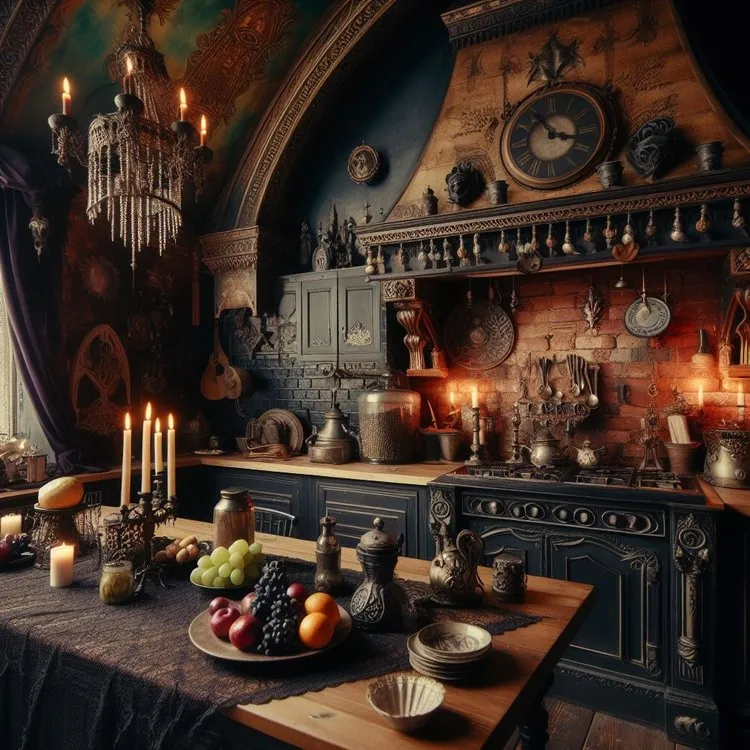The Allure of Gothic Kitchen Decor
Gothic kitchen decor is experiencing a resurgence, captivating homeowners with its dramatic flair and timeless elegance. This style transcends the typical kitchen aesthetic, offering a space that is both mysterious and inviting. The allure lies in its ability to create a unique atmosphere, a departure from the ordinary. It’s a style that speaks to those who appreciate history, craftsmanship, and a touch of the unconventional. Gothic kitchens often feature dark, rich colors, ornate details, and a focus on creating a space that feels both grand and intimate. The design principles draw heavily on the architectural styles of the medieval period, emphasizing high ceilings, arched doorways, and intricate patterns. This aesthetic allows you to express a unique personality, moving beyond the usual and embracing a kitchen that is truly a statement piece within your home.
Understanding the Gothic Aesthetic
To truly master gothic kitchen decor, it’s important to understand the fundamental elements that define the style. The gothic aesthetic is characterized by several key features: a strong emphasis on dramatic lighting, the use of dark and moody color palettes, and intricate detailing. Think of high ceilings, exposed beams, and arched doorways. Materials such as stone, dark wood, and wrought iron are also central to the aesthetic. Gothic design is not just about the visual elements, it is a mood. It should evoke a sense of mystery, history, and sophistication. This is achieved through careful selection of furnishings, accessories, and lighting. Creating a cohesive gothic space means balancing these elements and finding the right balance to convey the desired atmosphere.
Dark & Moody Color Palette
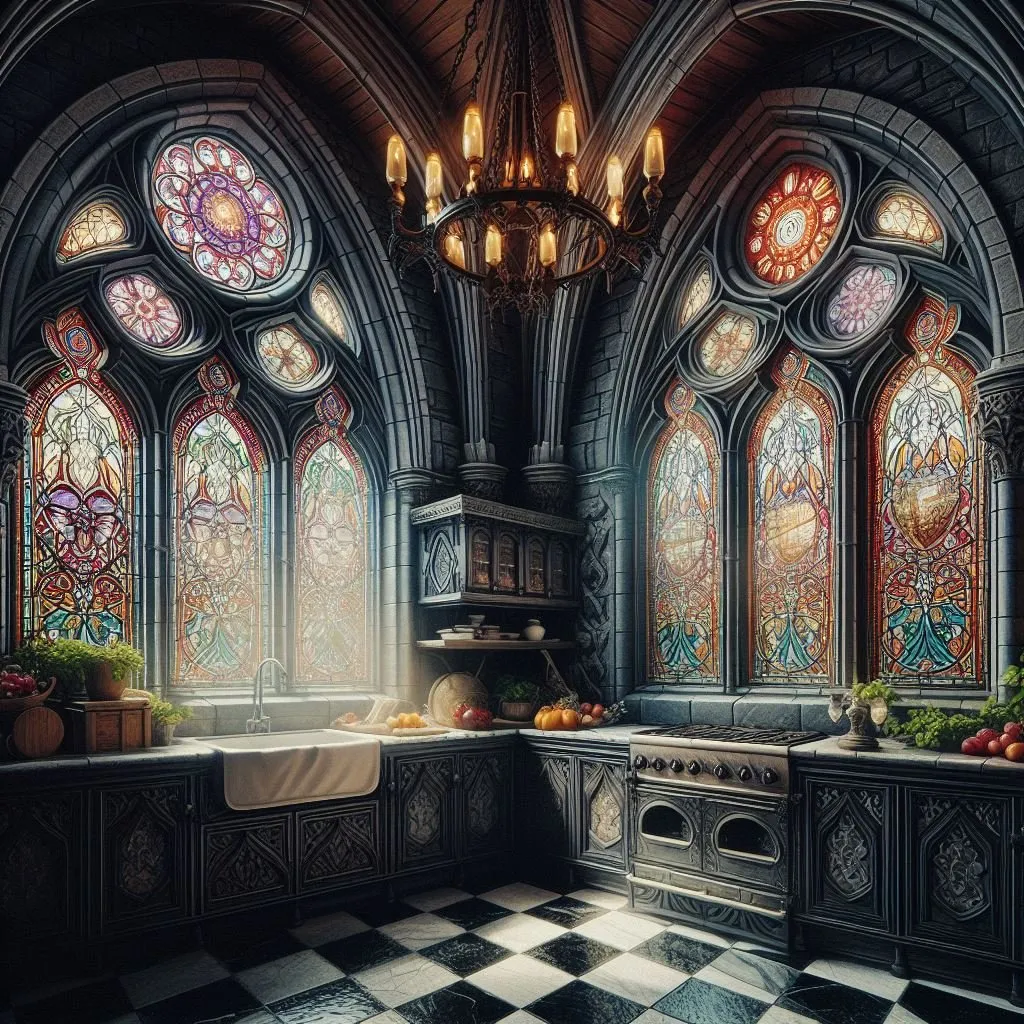
The color palette forms the foundation of a gothic kitchen. Embrace dark, saturated hues that evoke a sense of mystery and drama. Deep blacks, charcoal grays, and rich burgundy or plum tones are all excellent choices. These colors create a sense of depth and intimacy, making the kitchen feel both elegant and inviting. Don’t be afraid to experiment with accent colors, such as deep emerald green or metallic gold, to add pops of visual interest. These accent colors should be used sparingly, as to not distract from the overall dark ambiance. When choosing paint colors, consider the natural light in your kitchen. If your kitchen doesn’t receive much natural light, you may need to balance the darkness with strategic lighting choices. The goal is to create a space that is visually appealing and functional, and that includes considering the interplay of colors and light.
Embracing Dramatic Dark Tones
Incorporating dramatic dark tones requires careful consideration and planning. Start with your cabinetry, considering options like dark stained wood or painted cabinets in shades of black or deep gray. Balance the dark colors with lighter elements such as countertops in marble or granite, creating a contrast that adds visual interest. Flooring can be a key element in amplifying the gothic feel. Dark-stained hardwood, or stone-look tiles can work wonders. Don’t overlook the importance of wall paint, which should complement the cabinetry and flooring. The selection of materials is crucial. Dark tones will make any kitchen appear sophisticated and stylish. Careful planning is the key to achieving the look.
Incorporating Gothic Elements
Gothic kitchen decor is defined by specific architectural details and decorative elements. Arched doorways and windows, reminiscent of medieval architecture, can add a touch of grandeur. Intricate moldings, ornate carvings, and wrought iron details are other signatures. Think of adding gothic-style hardware to your cabinets and drawers, which can instantly elevate the look. Chandeliers with dark finishes, candelabras, and antique mirrors can all contribute to the gothic atmosphere. Be mindful of the balance, as too many elements can make the space feel cluttered. It is crucial to incorporate the elements carefully and strategically to achieve a cohesive and visually appealing gothic kitchen design. The goal is to add a touch of sophistication to your kitchen.
Choosing the Right Furniture
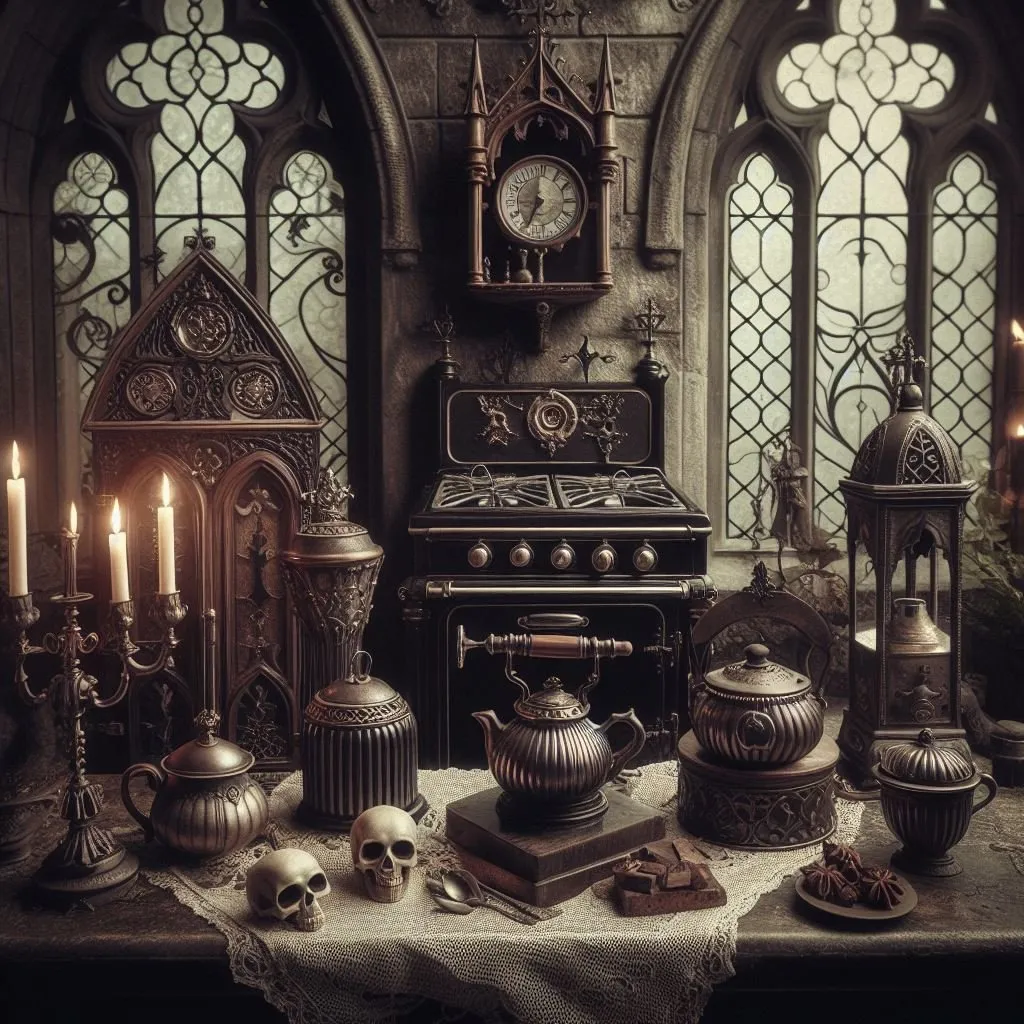
The right furniture is essential for completing a gothic kitchen. Opt for pieces that reflect the style’s dark, ornate aesthetic. Dark wood tables with carved details, high-backed chairs with velvet or leather upholstery, and antique-style cabinets are all excellent choices. Consider adding a kitchen island with a stone countertop and dark base to further enhance the gothic ambiance. The overall goal is to create a sense of history and luxury. Don’t be afraid to mix and match different furniture styles to create a unique and personalized look. When choosing furniture, make sure to consider the size and functionality of the items, as well as their aesthetic appeal. It’s all about finding a balance between style and practicality.
Selecting Gothic-Inspired Accessories
Accessories play a crucial role in defining the gothic character of your kitchen. Choose items that reflect the style’s dark and ornate aesthetic. Chandeliers with dark finishes, candelabras, and antique mirrors can create an atmosphere of mystery and sophistication. Wrought iron accents, such as pot racks or candle holders, are also excellent choices. Consider adding gothic-style tableware, such as dark-colored plates, goblets, and silverware. Don’t forget the importance of textiles, such as velvet or damask curtains. Choose items that add to the overall look and feel of the space. The aim is to create an atmosphere, so the accessories should contribute to the design and mood.
Lighting that Sets the Mood
Lighting is perhaps the most crucial element in a gothic kitchen. It can set the mood and dramatically impact the overall ambiance. Avoid harsh, fluorescent lighting. Instead, opt for a combination of layered lighting, including ambient, task, and accent lighting. Chandeliers with dark finishes or wrought iron details are perfect for creating a dramatic focal point. Add sconces or pendant lights with vintage-style bulbs to create a warm glow. Don’t underestimate the impact of candles, which can add a touch of romance and mystery. Make sure to use dimmers to adjust the lighting and create the desired atmosphere. By carefully selecting and positioning the lighting fixtures, you can turn your kitchen into a space that is both functional and aesthetically pleasing.
Creating Ambiance with Lighting
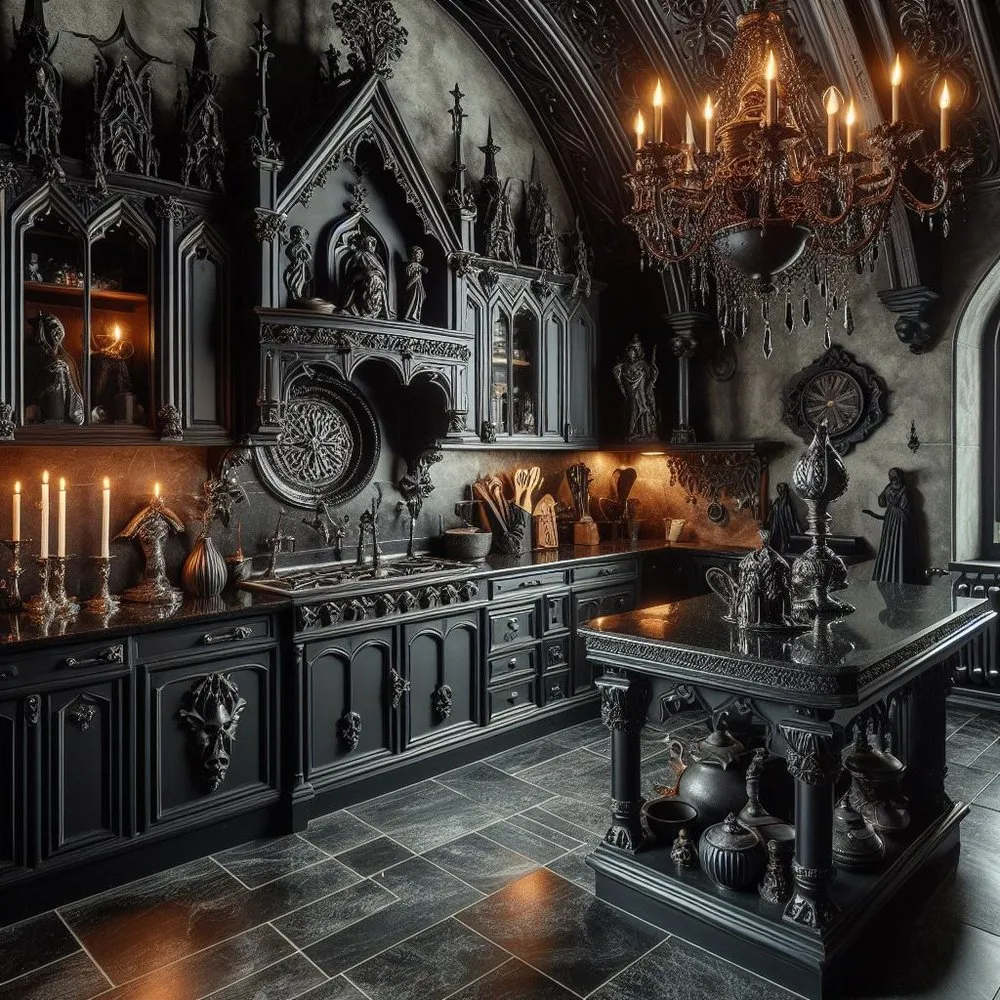
Creating the perfect ambiance with lighting involves layering different light sources to achieve the desired effect. Start with ambient lighting, which provides general illumination. Use a chandelier or pendant lights to create a focal point, ensuring it complements the overall gothic style. Add task lighting over the countertops and cooking surfaces, using spotlights or under-cabinet lighting. Finally, incorporate accent lighting to highlight architectural features and decorative elements. Use sconces or wall lights to create points of interest. The goal is to create a warm, inviting, and mysterious atmosphere. Remember to choose light bulbs with a warm color temperature to enhance the gothic aesthetic. The best lighting setup is one that is both practical and stylish.
Material Selection for the Gothic Kitchen
The materials you choose are integral to the aesthetic. Embrace materials that evoke a sense of history, luxury, and drama. Stone and dark wood are classic choices. Think of granite or marble countertops, dark-stained cabinetry, and exposed wooden beams. Wrought iron can be incorporated into the details, such as hardware, lighting fixtures, and decorative accents. Don’t overlook the importance of texture. Consider using textured tiles, or even a stone backsplash. The goal is to create a space that feels rich and inviting. When selecting materials, consider their durability and functionality, as well as their aesthetic appeal. The perfect combination is one that works well, and looks even better.
Working with Stone and Wood
Stone and wood are two of the most important materials. Choose stone for countertops, backsplashes, and even flooring. Granite, marble, and slate are all excellent choices, especially those with dark or veined patterns. For wood, opt for dark-stained or painted cabinetry. Consider exposed wooden beams, which can add architectural interest and create a sense of history. When using wood, choose a finish that complements the overall aesthetic. You might want to go for a distressed look. Stone and wood should be used in harmony, complementing each other to create a cohesive and visually appealing design. The combination will give any gothic kitchen a unique and stylish feel.
Adding Texture and Layers
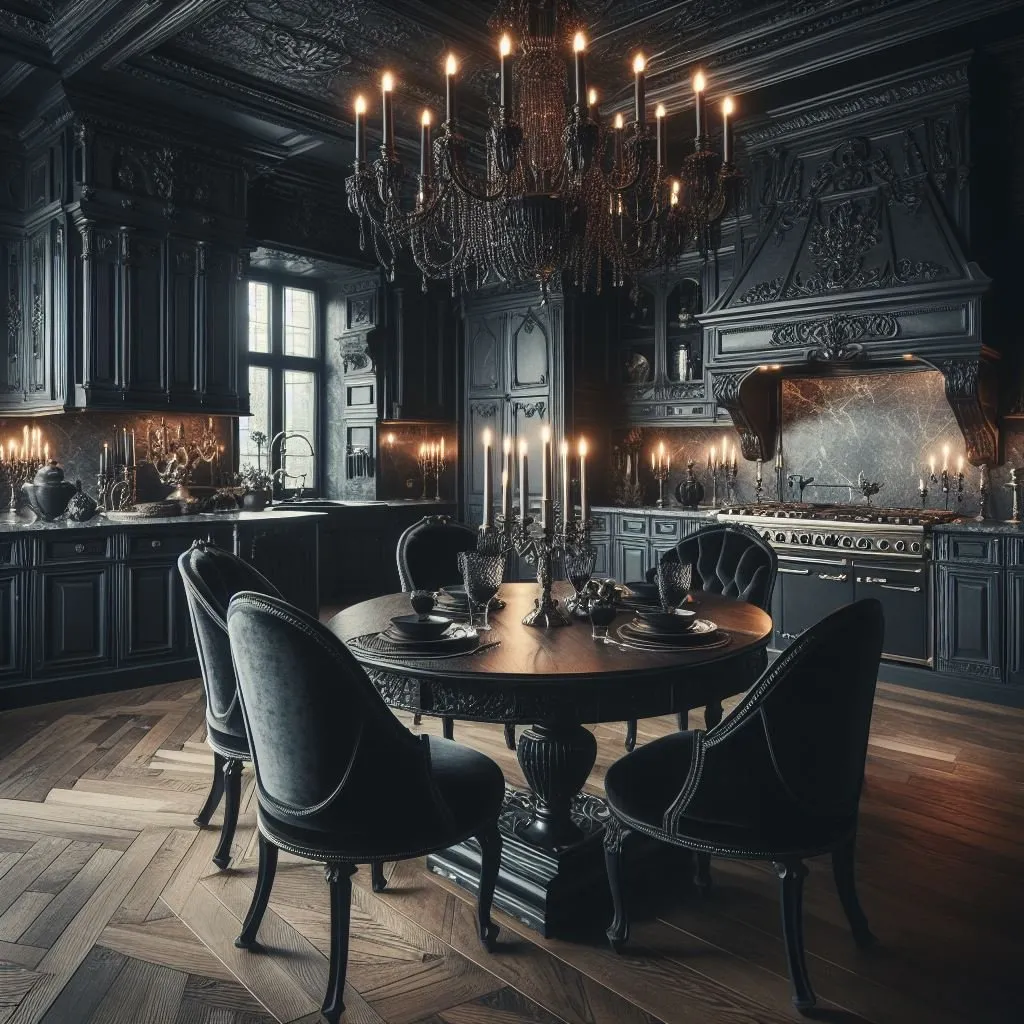
Texture and layering are essential components of a gothic kitchen design. Incorporate textures through the use of different materials and finishes. For example, consider a stone backsplash, or textured tiles. Use a combination of smooth and rough surfaces to create visual interest. Layering is also important. Combine different lighting sources, add decorative elements, and use a mix of textures to create depth and dimension. Consider adding textiles, such as velvet curtains or a patterned rug. By layering textures and patterns, you can transform your kitchen into a visually stimulating and inviting space. The key is to be creative and experiment with different combinations to achieve the desired effect.
Bringing It All Together
Bringing your gothic kitchen design to life requires careful planning and attention to detail. Start with a clear vision and plan each step. Choose a color palette, select the right furniture, and source the appropriate accessories. Be mindful of the lighting, and make sure that it complements the overall aesthetic. Don’t be afraid to experiment, mix different elements, and personalize your space. The goal is to create a kitchen that reflects your personality and style. Embrace the dark and dramatic elements. By following these steps, you can design a gothic kitchen that is both beautiful and functional.
Mixing Gothic with Modern
Mixing gothic with modern elements can create a kitchen that is both stylish and contemporary. Start by incorporating modern appliances and fixtures into your gothic design. Use sleek, minimalist cabinetry with dark finishes. Consider adding modern lighting, such as recessed spotlights or pendant lights. Don’t be afraid to mix different materials and textures, such as stone and stainless steel. By blending gothic and modern elements, you can create a kitchen that is both elegant and functional. The key is to find a balance between the two styles, ensuring that they complement each other.
